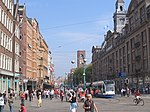Prostitution Information Center

The Prostitution Information Centre (PIC, Dutch: Prostitutie Informatie Centrum) is located in the heart of Amsterdam in the red light district, near Amsterdam's Old Church. The PIC serves as an educational centre and resource for providing Amsterdam's visitors with information and advice about prostitution.The practice of prostitution in the Netherlands was legalised nationally in October 2000. However, Amsterdam has long had a tolerant attitude towards prostitution, coupled with clear regulations that have been in force for many decades. Though prostitution is legal in Amsterdam, there is still a considerable amount of misunderstanding about it. The PIC's objective is to clear up some of that misunderstanding by providing visitors with accurate information regarding prostitution.
Excerpt from the Wikipedia article Prostitution Information Center (License: CC BY-SA 3.0, Authors, Images).Prostitution Information Center
Damrak, Amsterdam Centrum
Geographical coordinates (GPS) Address Phone number Website Nearby Places Show on map
Geographical coordinates (GPS)
| Latitude | Longitude |
|---|---|
| N 52.3747543 ° | E 4.8956064 ° |
Address
Beurs van Berlage
Damrak 243
1012 ZJ Amsterdam, Centrum
North Holland, Netherlands
Open on Google Maps








